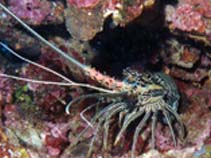Panulirus versicolor (Latreille, 1804)
Painted spiny lobster| Native range | All suitable habitat | Point map | Year 2050 |

|
| This map was computer-generated and has not yet been reviewed. |
| Panulirus versicolor AquaMaps Data sources: GBIF OBIS |
Classification / Names Common names | Synonyms | CoL | ITIS | WoRMS
| Decapoda | Palinuridae
Environment: milieu / climate zone / depth range / distribution range বাস্তুসংস্থান
; গভীরতার পরিসীমা 0 - 900 m (Ref. 4). Tropical; 35°N - 32°S, 31°E - 134°W (Ref. 4)
বিতরণ দেশ সমূহ | এফ এ ও এলাকাসমূহ | বাস্তুতন্ত্র | দৃষ্টিগোচর | প্রচলন
Indo-Pacific: from South Africa to Hawaii, including Red Sea and Persian Gulf, from Japan to Australia.
Length at first maturity / আকৃতি / ওজন / Age
Maturity: Lm 7.8, range 8 - ? cm Max length : 40.0 cm TL পুরুষ/ লিঙ্গ অনিধর্ারিত ; (Ref. 4)
Minimum depth from Ref. 96667. It has a maximum total body length of 40 cm, and an average length less than 30 cm (Ref. 4). Maximum depth from Ref. 105426. It occurs in shallow water, from the sublittoral down to 15 m; in coral reef areas, often on seaward edges of the reef plateau; in clear water also in surf areas. The species is nocturnal and not gregarious; in daytime, it hides in crevices and cavities of the rocks (Refs. 4, 9773). In general, palinurids are mainly considered carnivores, usually feeding upon sluggish, easily captured animals where most material is eaten alive or freshly killed (Ref. 105260). Feeds on bivalve mollusks and sea urchins (Ref. 9773).
Life cycle and mating behavior পরিপক্কতা | প্রজনন | ডিম ছাড়া | ডিমসমূহ | ডিম্বধারন ক্ষমতা | শুককীট
Members of the order Decapoda are mostly gonochoric. Mating behavior: Precopulatory courtship ritual is common (through olfactory and tactile cues); usually indirect sperm transfer.
Main reference
সূত্র সংখ্যা | সমম্বয়কারী | সহযোগী
Holthuis, L.B. 1991. (Ref. 4)
IUCN Red List Status (Ref. 130435)
Least Concern (LC) ; Date assessed: 03 December 2009
CITES status (Ref. 108899)
Not Evaluated
CMS (Ref. 116361)
Not Evaluated
Threat to humans
Human uses
মৎস্য: বাণিজ্যিক
| FishSource | আমাদের চতুর্পাশ্বের সাগর
হাতিয়ার
আরো তথ্য
প্রচলিত নাম সমূহ
প্রতিনাম সমূহ
শিকারী প্রাণী সমূহ
প্রজনন
পরিপক্কতা
ডিম ছাড়া
ডিম্বধারন ক্ষমতা
ডিমসমূহ
Egg development
প্রতিনাম সমূহ
শিকারী প্রাণী সমূহ
প্রজনন
পরিপক্কতা
ডিম ছাড়া
ডিম্বধারন ক্ষমতা
ডিমসমূহ
Egg development
ইন্টারনেট সুত্র
BHL | BOLD Systems | CISTI | DiscoverLife | FAO(Publication : search) | Fishipedia | GenBank (genome, nucleotide) | GloBI | Gomexsi | Google Books | Google Scholar | Google | PubMed | জীবন বৃক্ষ | Wikipedia (Go, অনুসন্ধান ) | জুলজিকাল রেকর্ড
Estimates based on models
Preferred temperature
(Ref. 115969): 9.8 - 22.9, mean 15.4 (based on 644 cells).
স্থিতিস্থাপক
(Ref. 69278):
মাধ্যম , সর্বনিম্ন প্রজন দ্বিগুনের সময় ১.৪-৪.৪ বৎসর (K=0.27; tm=3).
Prior r = 1.19, 95% CL = 0.79 - 1.79, Based on 1 data-limited stock assessment.
Nutrients: Calcium = 109 [35, 184] mg/100g; Iron = 1.59 [1.21, 1.97] mg/100g; Protein = 20.2 [19.2, 21.3] %; Omega3 = 0.285 [0.185, 0.386] g/100g; Selenium = 48.3 [-31.7, 128.3] μg/100g; VitaminA = 0 μg/100g; Zinc = 1.79 [1.17, 2.40] mg/100g (wet weight).



